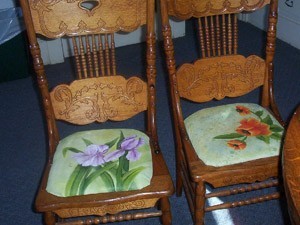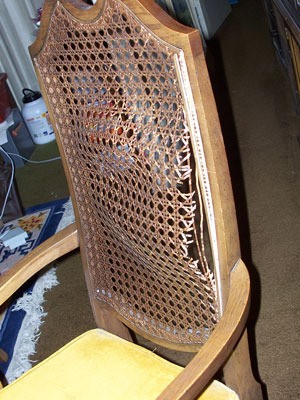 I have redone my antique dining chairs from caned seats to padded fabric seats without altering the cane part by cutting plywood seats that are slightly larger than the open area of the seats and adding thick blocks of wood with window hardware that turn to give a positive leverage under the wooden frame. I then cut foam padding and canvas and upholstered the plywood. I painted the canvas first. You could use any fabric of your choice. I varnish the canvas for wipe-ups.
I have redone my antique dining chairs from caned seats to padded fabric seats without altering the cane part by cutting plywood seats that are slightly larger than the open area of the seats and adding thick blocks of wood with window hardware that turn to give a positive leverage under the wooden frame. I then cut foam padding and canvas and upholstered the plywood. I painted the canvas first. You could use any fabric of your choice. I varnish the canvas for wipe-ups.
By Donna from Newell, IA
This page contains the following solutions.
Recover chair seats (such as dining chairs) on the cheap by using alternative fabric sources such as curtains found at second hand/thrift stores or clearance fabric table covers or sheets found just about anywhere.
Here are the questions asked by community members. Read on to see the answers provided by the ThriftyFun community.
 I have some dining room chairs that are probably over 40 years old.. The backing on the chairs is mostly caning with a wooden frame. It needs replacing in almost every chair. I am thinking it would be smarter to just buy new dining room chairs. Two of them have already separated within their wooden frames.
I have some dining room chairs that are probably over 40 years old.. The backing on the chairs is mostly caning with a wooden frame. It needs replacing in almost every chair. I am thinking it would be smarter to just buy new dining room chairs. Two of them have already separated within their wooden frames.
Hi Holly,
I can understand your dilemma about your dining chairs. I had a set that my grandmother had given me that was about 40 years old. I stripped and refinished the table and the hutch but I didn't bother with the chairs. They were very wobbly and I sat on one, it broke, and I ended up on the floor! I think that the cost of professional repair would be too high, and you could buy new chairs for the price of the repairs. I do think, though, if you were going to do the repairs yourself it would be worth keeping the old set. Instead of re-caning the backs of the chairs maybe you could cut wood to fit and upholster over it and re-upholster the seats to match? I certainly think that you should get a quote from a professional refinisher about your chairs and then with that price in mind go to the furniture store to see what new chairs would cost you.
We used some old oak chairs of my grandparents for many years. They were part of a kitchen set from the late 30's. I also had the table but one day it just split in two. My grandmother had kept laundry detergent and other "junk" on it in her basement for too many years. Well anyway, my husband refinished the chairs and I recovered the seats and those chairs were put with a unfinished round pedastal table my husband finished off. We used those same chairs for roughly 25 years. My hubby had done repairs to them over the years, tightened them up and such till they could be tightened no more. I recovered the seats more than once too. I then bought a new kitchen table and chairs and donated the old ones to charity.
My advice would be to go buy a new set if you can afford it or look in the paper or thrift shops for a new set. If you can't repair the chairs yourself, it will be very costly to hire it done. If the chairs do not have sentimental value to you, you may as well replace them. I'd replace the table too. Get a whole set that matches...you only live once.
I used those old chairs of my grandparents so many years when I'd probably rather have had something nicer....we could have afforded it but just didn't get around to it and kept using what we had.
Life's too short not to have something nicer, something safe to sit on and eat at....something you can be proud of when you have company.
Just my humble opinion :-)
Holly,
You can find directions on the internet for repairing caning yourself there are kits etc out there that can help you. If your chairs are from the 20s they may be worth more than you think they are. Where yours is in the shape that it is in though I would probably go with cutting a piece of thin plywood to fit the wood and upholstering it. As to replacement cost versus repair cost you need to realize somethings and decide what is important to you. Finding good furniture that is actually solid wood and well made these days is very difficult to do if you are buying new. There is no longer really a good quality economy version it's either expensive solid wood or cheap particle board covered with veneer. Repairing chairs really isn't that hard you don't have to hire someone to do it unless you have an ornate and extremely valuable antique. Anybody can take a chair apart sand all the joints and put it back together with dowels etc. and glue and clamp it its not as difficult as it seems.
How much fabric will I need for eight kitchen chairs?
By Marga
How much fabric you'll need depends on the kind of chair. Is there fabric on seat and back, or just back, or just seat? Look here for measuring and reupholstering advice:
furniture.about.com/
If you can, take the original fabric off one chair, then you know for sure. If not, measure the dimensions, allow for about 4" all around for undertacking/stapling, then you will have a good idea. If you want to have matching table runner or table clothes, add another 2 yards. I hope this helps. PBP
How much fabric do I need for reupholstering six dining room chairs?
By Cathy from Townsend, GA
You have to measure the width and length of the seats and then add about 4 inches to each measurement for folding under the seat. If the back is covered you do the same for that. Then figure the total number of inches and convert that into feet, then into yards, that will tell you how many yards of fabric you need.
You may find it easier to take one of the seats off the chair and take that current seat cover with you to a fabric store. The drapery fabrics are quite wide, sturdy and very often on sale. So, you can place your fabric on top of what's there, flip it over the number of seats you need. Get about 18" x 40" extra to make a table runner and voila! Easy peasy. Nicely coordinated chair seat covers and table decor to boot.
I hate that saying. LOL.
When reupholstering a chair, how do you remove the old seat back? There are wooden dowels hiding the screws. Do I drill them out or just use a chisel and hammer?
Depends. In any case the doweling is not likely too long. I'd first try drilling a small hole with a tiny bit into the doweling, then use the drill bit while in the hole to see if it is loose. If not, and if it appears to be glued, you may have to use a large bit to drill it on out.
Problem is that you need to determine how long the doweling is and how deep the screw it so you won't damage the screw head or you will have to drill it out too and then replace the deeper hole with new glued dowling and have a MUCH bigger job than you intended.
I'd just be VERY careful using the tiny bit, not drilling too deep, then perhaps on one of the holes put your drill in reverse, WITHOUT pulling out on the drill, to see if it will back out of the hole in this manner. SOMETIMES, if you're lucky, if doweling is glued, the glue is brittle and will just crack loose.
Another option is to use an eye dropper or spoon a few drops of water on the doweling, IF you determine it IS glued, so that the glue, which is likely waterbased Elmer's type wood glue, will soften and come on out after letting it sit for about an hour.
Don't over water it or it might swell the hole tighter.
If you do over-water, let it set in a dry place for a week to dry out and start over withOUT water.
Good luck and God bless and help you. : )
 I bought some dining chairs and I want to recover them. The seat part is straight forward, but they have a back cushion too. It's surrounded by wood around the top and sides and open at the bottom where I can see staples. I can't find screws on the side to open the sides to get it out, any ideas how I recover it?
I bought some dining chairs and I want to recover them. The seat part is straight forward, but they have a back cushion too. It's surrounded by wood around the top and sides and open at the bottom where I can see staples. I can't find screws on the side to open the sides to get it out, any ideas how I recover it?
By Kylie
I wonder, could the backs be held on with glue? See if you can put a flat head screwdriver between the seat back and the frame, and pry a bit to see if there is glue residue (jeez, I hope that made sense, lol!) Don't apply too much pressure. You don't want to splinter the wood backing, or gouge the frame. Choose a test area that is inconspicuous, too, just in case.
If the seat back is merely glued to the frame, you can use a thin paint brush to apply a nice coating of Gunk or a similar glue eater along the seam where the backing meets the frame. As the glue eater takes hold, slowly peel the backing away from the frame.
**Note: some of the glue eaters on the market nowadays also eat varnish, you may have to refinish the wood when you are finished recovering the chairs.
Once you have the backing off, recovering the back rest should be fairly straight forward. Look in a D-I-Y centre for a high quality glue to refasten the decorative back and use C clamps to hold the back in place while the glue sets (usually 24-48 hours). Protect the wood where the clamps touch it with padding like scrap towelling. You could use a teeny-tiny drill bit and create holes to drive screws in, but I don't think you'd be happy with the look.
I've seen this kind of construction before, usually in mid-high end ranges of furniture. The decorative backing isn't under the same sort of stress as the frame and seat areas, so using a strong glue makes for a safe fastener.
From the picture it looks as though you have got yourself a real bargain! Classic lines on the chairs, very nice.
I unscrewed the backs of my metal kitchen chairs and recovered them. Now I cannot get the screw to fit back into the chair back.
Cat from Boston, MA
I suspect the material you covered the chairs with is preventing the screws from being screwed into the screw holes. I would enlarge the hole in the material you covered the chair backs with and I think the screws would be able to be reattached.
ThriftyFun is one of the longest running frugal living communities on the Internet. These are archives of older discussions.
Any help on reupholstering dinning chairs, would be appreciated.
I am presently re-upholstering my daughter's dining room chairs. I removed the old cover and picked the stitching apart and used the old piece to make a new pattern.
Turn your old chairs, or even thrift store finds, into custom dining room furniture. With some unique fabric, any chair that has a removable seat can become new again.